Ron Szasszer’s love for patina drew him towards a well-worn 356 Speedster. Discovering its history fostered a close connection between him and the man who used to race it.
Nature has slowly wrestled control over the Marlboro Motor Raceway, with birch trees sprouting from the tarmac, though the grandstands are still mostly intact.
The Marlboro Motor Raceway was a venue racing royalty would be seen, with talented drivers like Mario Andretti, Paul Newman, and Roger Penske, to name just a few. In fact, in 1964, Jackie Stewart was victorious in the 12-hour race on this circuit, driving a Lotus Cortina.

80-year-old privateer racer Edward Parlett, who was a veteran of the circuit, reminisced:
“This racetrack closed down shortly after I retired from motorsport. I think that means I still hold the lap record here. And that is then a record forever.”
After getting his competition license at Marlboro, Parlett made his debut race and eventually won two six-hour endurance events.


He was a local racer within a group called the ‘Philly gang,’ which included Jack Heron, Bob Lorrailliere, Ray Kraftson, and Nagle Bridwell. Some photos were taken at the time, showing them hanging around a 356 A 1600 Super Speedster, which was Parlett’s long-term and last racing car – the very car that Ron Szasszer currently owns today.

Going back to 2008, Szasszer was in his flat, hunting online car deals with one eye on the screen and the other on the TV playing in the background.
“I didn’t really want to buy anything, and also not a Porsche,”
Ron Szasszer
Although Szasszer grew up around cars, he had no strong attachment with Porsche. The photos he had of his father, an immigrant from Hungary who ended up in Miami, showed his father leaning against giant Chevys. He himself got a beetle for his own first car, which he built from two scrap Beetles.
The Workshop in Hamburg
Szasszer’s second vehicle was another Beetle, a Cali-look Oval Beetle that had a lowered suspension, finished in matte black, and was fitted with outsized tires.

While in university, Szasszer partnered with his friend, Jens Wilke, where they set up a workshop in an old station building east of Hamburg. They rebuilt Volkswagens for people who wanted to own a car that was not a Trabant after German reunification.
For himself, he purchased an unfinished Jaguar E, with a Porsche never entering his thoughts. In 1996, the partners closed the workshop, and by then Szasszer had a Land Rover Series III.
The next car he had was a Mercedes Pagoda that served him well for his everyday use for eight years before buying a 993.
Recalling the moment he saw the car, he stated:
“I have always had a weak spot for patina, for racing history, for starting numbers on doors, and somehow I must have been looking for that.”
Eventually, his attention was caught by a 1957 356 A 1600 Super Speedster being sold by a dealer in Austria. The unit still had its original racing trim and had orange paintwork.

“There was hardly any description for it, and there was also no price. There was just a comment that it had competed in many major races on the East Coast of the US and that it once belonged to a driver called Ed Parlett. For me, it was love at first sight,”
He quickly put a down-payment on the car, although he wisely decided to delay informing his wife for the time being…..
Modernising the 356 A 1600 Super Speedster
Once the payment has been transferred, the dealer shipped the car from America, where Szasszer claimed it from Austria.
In Hamburg, he searched for a firm that would not only reinstall the engine but be able to get it road-worthy to drive, too.
Szasszer did not want the appearance to be changed, though a degree of modernization was impossible to avoid.

They replaced the original racing bucket seat, created a space for a passenger, removed the large roll bar, and a metal tank replaced the old fuel bladder. An original windscreen replaced the wind deflector, and Szasszer himself acquired old magnesium wheels that still had the 50-year-old Goodyear rubber, the same ones Parlett used in the 1960s. It was only then that Szasszer became curious enough to start reading up on his racing car’s mystery driver.
“There was only one hit for the name on the Internet, and that didn’t help me,” Szasszet recalled. Ultimately it was his Business English teacher who was the one who solved the mystery. One day, the teacher arrived with the news that he had talked to Parlett while he was in the US. “Ed was alive! I was totally fascinated!”

Less than a week later, he and an interpreter got on a plane to Maryland, and the story of the car started to be revealed.
“Parlett started racing at the beginning of the 60s. Following his mother’s advice, he had already bought a used 356 for everyday driving in 1959 as a student. Later, while working in the medical equipment industry, he got to know Nagle Bridwell, one of the Philly gang, who lured him into racing.”
In 1965, Bridwell retired from racing, and Parlett was the one who acquired the 356 Speedster.
In 1969 in Limerock, the car had a sticky end, and with the engine and transmission in hand, Parlett searched for a new car. He did not have to go far, as his friend, Bruce Baker, had chassis number 84333 at his dealership.

The chassis was one of the last Speedsters that were produced in Reutter in Stuttgart in December 1957. It was then brought to Max Hoffman in New York through Bremerhaven.
Baker acquired the car from another racer, Dick Scarborough, and Parlett gave it another chance on track in the coming years.
Despite Parlett not having a natural talent for racing, he did have a talent for tinkering with the machines, right down to the very last detail.
He designed the wind deflector and installed a Super 8 camera in a wheel housing to observe how the chassis worked.

Badges within the vehicle show that Parlett and his 356 Speedster were victorious at the Barrel of Fun Rally in the PCA Chesapeake Region on 21 September 1963.
They also participated in the National Races on the Steel City International Raceway near Detroit at the end of September 1967 and the Appalachian National Rally in the Philadelphia Region in 1969.
The busy and well-traveled duo were also class winners in the Bryar Nationals in New England in 1972.
Szasszer Meeting with Ed Parlett
In 1975, Parlett retired from racing and sold the car to TWA driver Jack Klinges in Bethlehem, Pennsylvania. Tom Miller of Miller Sportscars discovered the car and ultimately brought it back to Europe.
Szasszer eventually returned the Porsche to the road in 2011 and regularly met up with Parlett during this time to gain a better understanding of its background. In 2012, the race veteran handed Szasszer his helmet and full race records as well as racers’ old invoices.
Unfortunately, the following year, Parlett passed away, but Szasszer has maintained his legacy since then.

The Speedster still proudly carries the traces of rubber from its final race roughly 50 years ago and is still regularly driven despite the less than perfect Hamburg weather.
Szasszer also runs the United Garages Instagram account, where he and the 1,500 subscribers share their love for a Porsche with patina.
[Source: Porsche AG]


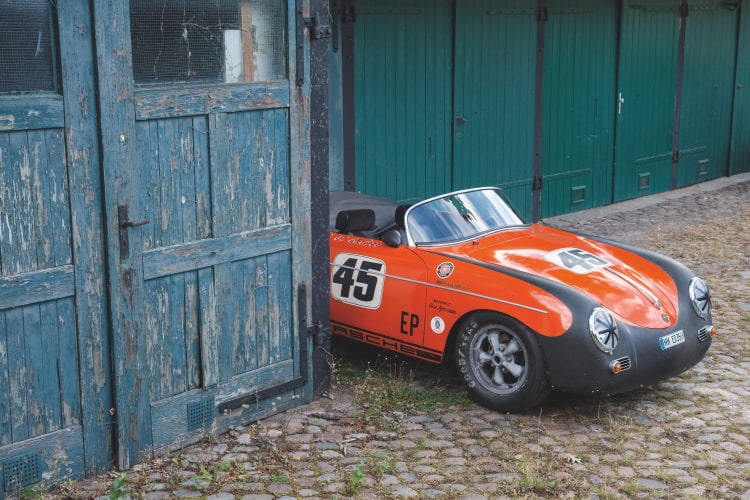
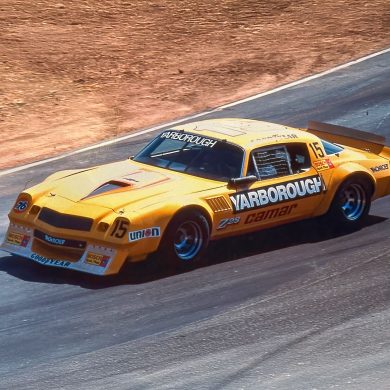
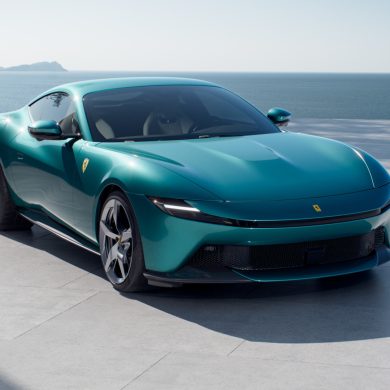
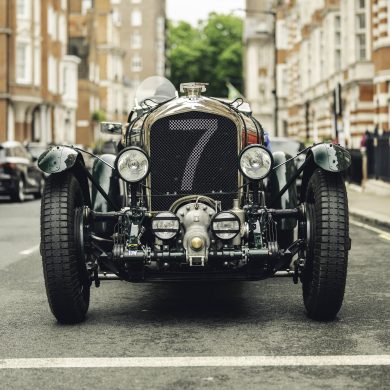
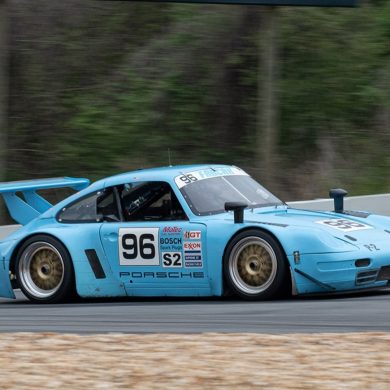
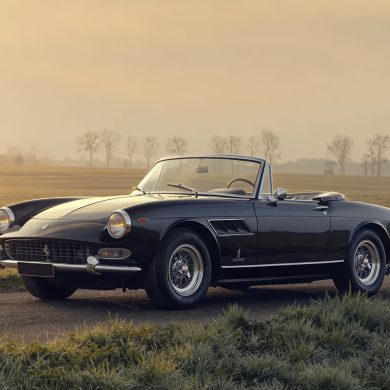
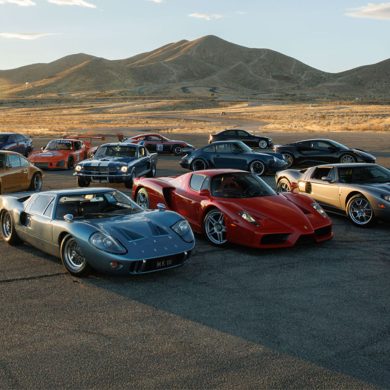


Small world. I looked at this Speedster when the TWA pilot owned it but bought Ed’s first Speedster from Bruce Baker, the one he had purchased from Nagle! We four plus Steve Limbert another owner met in NOV 09’ to see my Speedster restored by Bruce.
The photo of the gold version of the Speedster are almost surely taken at the Cumberland Road Races, likely in the late 60s or early 70s. The hills in the background are distinctive, as well as the large concrete expanse of the pit area. The period is obvious with cars, equipment and clothes of the period.
“Ed Parlett in his element: car, cigarette and wife.” Sounds like paradise!
Best wishes from Toronto.
The 1964 12 at Marlboro was not won by Jackie Stewart. There were a bunch of Lotus Cortina works racers but the race was won by Monte Winkler and Pete Vandervate driving an Alfa Romeo TI Super.
Nagle Bridwell and I had identical Super. Speedsters which we bought in Phila. at just about the same time. I knew him, but not well. Interesting to know that his is still running. He was a really good driver.
Marlboro brings back memories, I attended one or the first SCCA driver’s school there in 1960. D. Black ( SP250) was my instructor. The start of the practice races was “fun” one lap of the oval from a standing start and then out to the road course. I was stationed at Ft. Bragg NC at the time driving a new 100-6 Healey. Retired from racing in 2014.
I’m a little curious about the VIN number stated in the article. 84333 used to belong to Cheryl Dunkle and was sold at the Mecum auction: https://www.mecum.com/lots/CA0813-161606/1958-porsche-356a-speedster-race-car/
My car is 84332, just ahead on the production line.
that’s what I love about the world wide web: it connects people and their stories! Thanks for that and thanks for your comments!
If you think of anything else about the Speedster and the guys around the car let me know: Ed Parlett, Nagle Bridwell, Rob Lorrilliere, Steve Limbert, Dick Scarborough, Jack Heron, Raymond H. Kraftson, Dick Merriman, Jack Klinges …
Ronald John Szasszer
Hi Ronald, Great to hear from you! Enjoy your car- it’s a keeper!
Cheryl Dunkle owned and raced Speedster 84333 and sold it at auction through Mecum back in August 2013.
The author is mistaken on the VIN of Szasszer’s car.